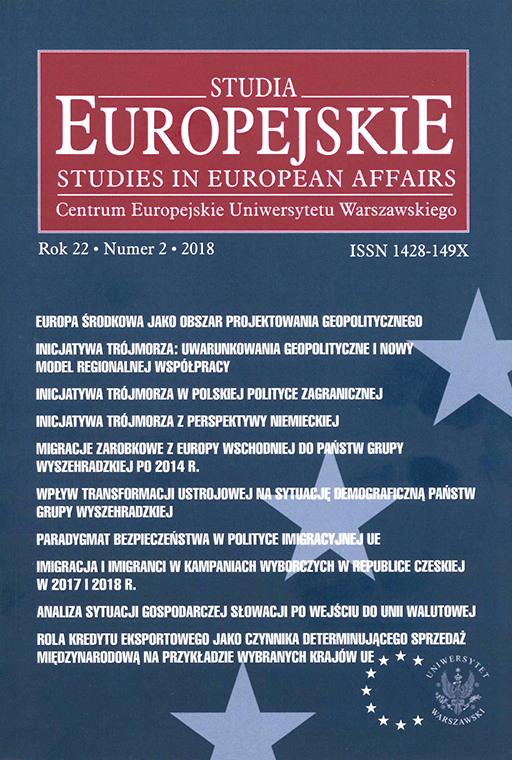
ISSUE: 2/2018
- Volume 22
- Number 2
- 2018
Subscribe NEWSLETTER
Studia Europejskie –
Studies in European Affairs
ISSN: 1428-149X
e-ISSN: 2719-3780
License
Articles published in the journal are under a Creative Commons Attribution – Non Commercial – No Derivatives 4.0 International License
Analiza sytuacji gospodarczej Słowacji po wejściu do unii walutowej
Central Europe as a Geopolitical Projecting Area
Abstract
The Slovak economy has experienced strong but relatively short period of recession in 2009. Subsequent economic recovery was stimulated by growing exports and investment spending. Although subsequent GDP growth was among the highest in the OECD countries, the employment rate has not yet reached pre-crisis level and the unemployment rate remains at a high level. According to research presented in the paper, Slovakia joined the euro area after a period of unprecedented appreciation of the korona, which created a threat to the competitiveness of the Slovak economy, which relies heavily on export-oriented production. This led ultimately to an internal devaluation and increase the productivity of factors of production, including price reductions of capital and reducing the number of workers in the low productivity sectors. Although this strategy has successfully restored the external balance, its consequence for domestic demand and employment were less positive.
References
Ambroziak A.A., Pomoc publiczna państw członkowskich UE w okresie kryzysu gospodarczego w latach 2008–2010, „Unia Europejska.pl”,
nr 214(3)/2012.
Backe P., Wójcik C., Credit booms, monetary integration and the new neoclassical synthesis, “Journal of Banking and Finance”, no. 32(3)/2008.
Baldwin R., The euro’s trade effects, “Working Paper”, no. 594/2006.
Berka M., Devereux M.B., Engel Ch., Real Exchange Rate Adjustment in and out of the Eurozone, “American Economic Review: Papers & Proceedings”, no. 102(3)/2012.
Brixiova Z., Vartia L., Wörgötter A., Capital fl ows and the boom-bust cycle: The case of Estonia, “Economic Systems, Elsevier”, vol. 34(1)/2010.
Bussière M., Fidrmuc J., Schnatz B., EU Enlargement and Trade Integration: Lessons from a Gravity Model, “Review of Development Economics”, no. 12(3)/2008.
Broeck de M., Mehrez G., Guscina A., Assessing Competitiveness Using Industry Unit Labour Costs: an Application to Slovakia, International Monetary Fund, “Working Papers”, no. 12/107/2012.
Cajka R., Gajduskova K., Bolotov I., Comparison of impact of the economic crisis and anti-crisis measures on the Czech Republic and Slovakia, “Managemen & Gouvernance”, vol. 4/2011.
Egert B., Catching-up and infl ation in Europe: Balassa-Samuelson, Engel’s Law and other culprits, “Economic Systems”, no. 35(2)/2011.
European Commission, Country Report Slovakia 2014, Commission Staff Working Document, SWD(2014) 44 final/2, Brussels 2015.
Fabrizio St., Igan D., Mody A., The Dynamics of Product Quality and International Competitiveness, International Monetary Fund, “Working
Paper”, no. 7/97/2007.
Fidrmuc J., Hainz C., Default rates in the loan market for SMEs: Evidence from Slovakia, “Economic Systems”, no. 34(2)/2010.
Fidrmuc J., Senaj M., Human Capital, Consumption and Housing Wealth in Transition, National Bank of Slovakia, Bratislava, “Working Paper”,
no. 2/2012.
Frankel J., Rose A., An estimate of the effect of common currencies on trade and income, “Quarterly Journal of Economics”, no. 117/2002.
Hufner F., Koske I., The Euro Changeover in the Slovak Republic: Implications for Infl ation and Interest Rates, OECD, “Economics Department
Working Papers”, no. 632/2008.
IMF, Slovak Republic: 2011. Article IV Consultation – Staff Report; Informational Annex; and Public Information Notice on the Executive Board
Discussion, “Country Report”, no. 11/122/2011.
Krugman P., Lessons of Massachusetts for EMU, Cambridge University Press, Cambridge 2013.
Kupczyk R., Przyczyny kryzysu w strefie euro – ujęcie teoretyczne, w: Zarządzanie gospodarcze Unii Europejskiej w drugiej dekadzie XXI wieku, red. I. Kraś, Difin, Warszawa 2016.
Morvay K., Okali I., Gabrielova H., Hvozdikova V., Economic Development of Slovakia in 2011 and Outlook Up to 2013, “Ekonomicky casopis/Journal of Economics”, 2012.
Muchova E., Slovak Economic Growth and the Consistency of the Balance of Payments Constraint Approach, “Estudos Do Gemf ”, no. 16/2012.
OECD, “Economic Outlook”, no. 91/2012.
Oomes N., Maintaining Competitiveness Under Equilibrium Real Appreciation: The Case of Slovakia, International Monetary Fund, “IMF Working Papers”, no. 5/65/2005.
Oszako-Pietrzak A., Stosunki gospodarcze Polski ze Słowacją, w: Stosunki gospodarcze Polski z państwami Europy Środkowej i Wschodniej po rozszerzeniu Unii Europejskiej, red. J. Kaliński, Oficyna Wydawnicza SGH, Warszawa 2011.
Walch N., Worz J., The Impact of Country Risk Ratings and of the Status of EU Integration on FDI infl ows in CESEE Countries, “Focus on European Economic Integration, Oesterreichische Nationalbank”, issue 3/2012.
Language: Polish
Pages: 151-167
How to Cite:
Harvard
Kupczyk, R. (2018) "Analiza sytuacji gospodarczej Słowacji po wejściu do unii walutowej". Studia Europejskie – Studies in European Affairs, 2/2018, pp. 151-167.